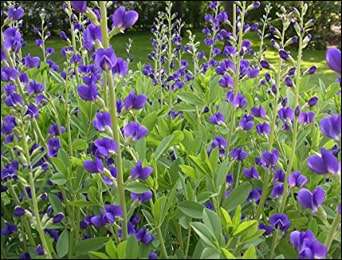
Overview
It is a perennial flowering plant. Wild Indigo grows slowly, developing into clumps with extensive and deep roots. It should not be disturbed once develop. Wild Indigo can be grown from seed but it takes several years to get mature . After blooming, it takes up a shrubby appearance. To maintain its rounded appearance it should be trimmed timely. It reproduces both sexually and asexually. Wild Indigo develops easily in loamy, fertile soil in gardens. This plant never suffers from a serious disease or insect problems. Taller plant of this species may need support, mainly when growing in a partially shaded location.
What are the common names used for Wild Indigo?
Blue false indigo, yellow false indigo, rattle weed, wild indigo, rattle bush, and horsefly weed.
What is the Botanical name for Wild Indigo?
Baptisia australis
How is Wild Indigo Scientifically Classified?
- Kingdom – Plantae
- Phylum – Angiosperms
- Subphylum – Eudicots
- Class – Rosids
- Order – Fabales
- Family – Fabaceae
- Genus – Baptisia
- Species – B.australis
General Description of Wild Indigo
It is an upright plant which grows up to the height of 3-4 feet. This plant grows in rich woods and develops from the rhizomatic network. Roots of Wild Indigo is deep and branched which helps it to withstand drought conditions. Its branches are hairless and smooth. Sap secreted from it becomes blue on coming in contact with air. Leaves are grey-green in color and are arranged alternately. Its leaflets are clover-like and obovate in shape. Flowers are purple in color and do not have any fragrance. Flowers of this plant blooms in spring. Fruits are bluish black in color, oblong in shape and tipped at the apex. Seeds of this plant are yellowish brown in color and are kidney-shaped.
Where is Wild Indigo Distributed?
It is distributed to central and eastern North America commonly in the Midwest.
Which is the Suitable area for Cultivation of Wild Indigo?
It grows best naturally at the borders of woods, in open meadows or along streams. It grows well in full sun or partially shaded area. This plant requires water only in times of low rainfall.
Which parts of the plant are used for the Medicinal Purpose?
Whole plant
What are the Medicinal uses of Wild Indigo?
- It is used to treat insect bites.
- This plant has anti-oxidant action, eliminates free radicals or oxidants from the body. It increases the immunity of the body and strengthens the body to fight against infections and diseases.
- Cold tea made from this herb helps to stop vomiting.
- Its poultice is anti-inflammatory which helps to relieve pain, redness and swelling when applied externally to the affected part.
- Wild indigo helps to treat a toothache.
- This herb helps to remove excess of mucus from the body, mainly used in ear, nose and throat infections.
- It can be used to reduce the temperature in fever and also helps to relieve other symptoms like body ache and congestion of body parts.
- Constipation can be treated by the use of this herb as it has a laxative action.
- Wild indigo helps to treat inflammation of larynx and tonsils as well.
- Its dilution or decoction can be used as a mouthwash to treat oral ulcers.
- This herb also treats leucorrhea.
- Wild indigo improves digestion and increases appetite.
- It also helps to treat many infective conditions like diphtheria, influenza and other respiratory tract infections.
- Its roots can be used to relieve cuts, wounds and other skin conditions.
- Tea made from Wild indigo is useful to treat fever and pharyngitis. It can be taken once a day.
- The whole plant of Wild indigo can be used to treat asthma, kidney diseases, gonorrhea, cough and bronchitis.
- An ointment made from it can be used to relieve soreness and colic.
- Powder made from this herb is used to relieve itching occurs in eczema and other skin conditions.
- In homeopathy, it is used under name of the remedy Baptisia tinctoria. It has gained a high reputation worldwide as a typhoid remedy. It effectively treats symptoms of typhoid fever-like profound prostration, aching head, sore throat, pains all over the body and blurry eye vision. It is also used to treat many other conditions like sepsis or serious infections.
What can be the Side Effects of Wild Indigo
Intake of large doses can cause
- Vomiting
- Diarrhea
- Spasms
- Other intestinal conditions
